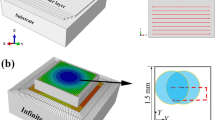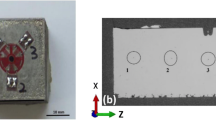Abstract
Selective laser melting (SLM) is an additive manufacturing method that generates much residual tensile stress during processing. Laser shock forging (LSF) is a surface treatment technology that can reduce residual stress on the metallic surface. At present, there are no reports on in situ LSF (ILSF) during the SLM process. The effect of ILSF on the residual stress field induced by SLM was systemically investigated using the finite element method (FEM), and the parameters were optimized. Optimized finite element simulation calculated the stress field after the ILSF impact. The results show that the SLM deposition layers have significant residual tensile stress, with a maximum range of 152 μm and extremely inhomogeneous distribution. LSF can convert SLM-induced tensile stress into compressive stress. The two most important ILSF parameters are peak pressure (Pmax) and initial temperature (Ti). The range and magnitude of the residual compressive stress field increases with Pmax and decreases with the initial temperature. The sufficiently large LSF Pmax is essential in the LSF process. When Pmax is large enough, the effect of the multiple shots on the magnitude and depth of compressive stress is insignificant. The high Ti will significantly reduce the effect of ILSF, even if residual compressive stress is not obtained. Ti influences the stress field through an inhomogeneous temperature gradient. The temperature gradient is strongly correlated with the residual stress variation, and the fitted equation shows that the stress field is a power function of the temperature gradient. This paper provides an essential guide to improving the residual stress field in additive manufacturing processes.













Similar content being viewed by others
Data availability
Not applicable.
References
Kruth JP, Levy G, Klocke F, Childs THC (2007) Consolidation phenomena in laser and powder-bed based layered manufacturing. CIRP Ann 56:730. https://doi.org/10.1016/j.cirp.2007.10.004
De A, DebRoy T (2013) A perspective on residual stresses in welding. Sci Technol Weld Join 16:204–208. https://doi.org/10.1179/136217111x12978476537783
Deng D, Murakawa H, Liang W (2008) Numerical and experimental investigations on welding residual stress in multi-pass butt-welded austenitic stainless steel pipe. Comput Mater Sci 42:234–244. https://doi.org/10.1016/j.commatsci.2007.07.009
Akita M, Uematsu Y, Kakiuchi T, Nakajima M, Kawaguchi R (2016) Defect-dominated fatigue behavior in type 630 stainless steel fabricated by selective laser melting. Mater Sci Eng A 666:19–26. https://doi.org/10.1016/j.msea.2016.04.042
Fang Z-C, Wu Z-L, Huang C-G, Wu C-W (2020) Review on residual stress in selective laser melting additive manufacturing of alloy parts. Opt Laser Technol 129:106283. https://doi.org/10.1016/j.optlastec.2020.106283
Ji W, Liu C, Dai S, Deng R (2023) Microstructure, properties and crack suppression mechanism of high-speed steel fabricated by selective laser melting at different process parameters. Chin J Mech Eng 36:46. https://doi.org/10.1186/s10033-023-00877-7
Ravichander BB, Mamidi K, Rajendran V et al (2022) Experimental investigation of laser scan strategy on the microstructure and properties of Inconel 718 parts fabricated by laser powder bed fusion. Mater Charact 186:111765. https://doi.org/10.1016/j.matchar.2022.111765
Gujba AK, Medraj M (2014) Laser peening process and its impact on materials properties in comparison with shot peening and ultrasonic impact peening. Materials (Basel) 7:7925–7974. https://doi.org/10.3390/ma7127925
Peyre P, Fabbro R, Merrien P, Lieurade HP (1996) Laser shock processing of aluminium alloys. Application to high cycle fatigue behaviour. Mater Sci Eng A 210:102–113. https://doi.org/10.1016/0921-5093(95)10084-9
Liu L, Wang J, Zhou J (2019) Characterization and analysis on micro-hardness and microstructure evolution of brass subjected to laser shock peening. Opt Laser Technol 115:325–330. https://doi.org/10.1016/j.optlastec.2019.02.043
Wu J, Zhao J, Qiao H, Hu T, Li S (2019) Effect of temperature-assisted laser shock peening on mechanical properties of GH4169 alloy. J Plast Eng 26:199–205. https://doi.org/10.3969/j.issn.1007-2012.2019.01.030
Li Y, Fan J, Wen J, Nie X, Zhou L (2022) Study on the effects of multiple laser shock peening treatments on the electrochemical corrosion performance of welded 316L stainless steel joints. Metals 12:1215. https://doi.org/10.3390/met12071215
Lu J, Lu H, Xu X, Yao J, Cai J, Luo K (2020) High-performance integrated additive manufacturing with laser shock peening –induced microstructural evolution and improvement in mechanical properties of Ti6Al4V alloy components. Int J Mach Tools Manuf 148:103475. https://doi.org/10.1016/j.ijmachtools.2019.103475
Li X, Wei X, Zhang L, Lv Q (2023) Numerical simulation for the effect of scanning speed and in situ laser shock peening on molten pool and solidification characteristics. Int J Adv Manuf Technol 125:5031–5046. https://doi.org/10.1007/s00170-023-10897-1
Chen S-G, Zhang Y-D, Wu Q, Gao H-J, Gao Z-H, Li X (2021) Effect of solid-state phase transformation on residual stress of selective laser melting Ti6Al4V. Mater Sci Eng A 819:141299. https://doi.org/10.1016/j.msea.2021.141299
Gu D, He B (2016) Finite element simulation and experimental investigation of residual stresses in selective laser melted Ti–Ni shape memory alloy. Comput Mater Sci 117:221–232. https://doi.org/10.1016/j.commatsci.2016.01.044
Kim J-S, Nam H-S, Kim Y-J, Kim J-H (2017) Numerical study of laser shock peening effects on alloy 600 Nozzles with initial residual stresses. J Press Vessel Technol 139:041406. https://doi.org/10.1115/1.4035977
Yang Y, Zhao J, Qiao H et al (2021) The simulation and experiment of In 718 in warm laser shock processing without coating. J Russ Laser Res 42:340–350. https://doi.org/10.1007/s10946-021-09967-0
Yilbas BS, Akhtar SS, Karatas C (2010) Laser surface treatment of Inconel 718 alloy: thermal stress analysis. Opt Lasers Eng 48:740–749. https://doi.org/10.1016/j.optlaseng.2010.03.012
Sandmann P, Keller S, Kashaev N et al (2022) Influence of laser shock peening on the residual stresses in additively manufactured 316L by laser powder bed fusion: a combined experimental–numerical study. Addit Manuf 60:103204. https://doi.org/10.1016/j.addma.2022.103204
Hatamleh MI, Sadeh S, Farooq T, Malik AS, Qian D (2018) Finite Element Study of Laser Peening on Selective Laser Melted A357 Aluminum Alloy During Tension Test. Proceedings of the ASME 2018 13th International Manufacturing Science and Engineering Conference. Volume 4: Processes. College Station, Texas, USA. June 18–22, 2018. V004T03A046
Kalentics N, Huang K, de Seijas MOV, Burn A, Ramano V, Logé RE (2019) Laser shock peening: a promising tool for tailoring metallic microstructures in selective laser melting. J Mater Process Technol 266:612–618. https://doi.org/10.1016/j.jmatprotec.2018.11.024
Kalentics N, Boillat E, Peyre P, Ćirić-Kostić S, Bogojević N, Logé RE (2017) Tailoring residual stress profile of selective laser melted parts by laser shock peening. Addit Manuf 16:90–97. https://doi.org/10.1016/j.addma.2017.05.008
Zhou J, Zhou X, Li H, Hu J, Han X, Liu S (2022) In-situ laser shock peening for improved surface quality and mechanical properties of laser-directed energy-deposited AlSi10Mg alloy. Addit Manuf 60:103177. https://doi.org/10.1016/j.addma.2022.103177
Zhang Y, Cai S, Yang Z et al (2023) Laser shock forging—a novel in situ method designed towards controlling residual stresses in laser metal deposition. Int J Adv Manuf Technol 125:2289–2304. https://doi.org/10.1007/s00170-023-10874-8
Fabbro R, Fournier J, Ballard P, Devaux D, Virmont J (1990) Physical study of laser-produced plasma in confined geometry. J Appl Phys 68:775–784. https://doi.org/10.1063/1.346783
Romano J, Ladani L, Sadowski M (2016) Laser additive melting and solidification of Inconel 718: finite element simulation and experiment. JoM 68:967–977. https://doi.org/10.1007/s11837-015-1765-1
High Temp Metals (2015) INCONEL 718 TECHNICAL DATA. https://www.hightempmetals.com/techdata/hitempInconel718data.php#6. Accessed 25 September 2022
ER Denlinger (2018) Thermo-Mechanical Modeling of Additive Manufacturing. Elsevier, Amsterdam
Pottlacher G, Hosaeus H, Wilthan B, Kaschnitz E, Seifter A (2002) Thermophysikalische Eigenschaften von festem und flüssigem Inconel 718. Thermochimica Acta 382:255–267. https://doi.org/10.1016/s0040-6031(01)00751-1
Cao L (2021) Workpiece-scale numerical simulations of SLM molten pool dynamic behavior of 316L stainless steel. Comput Math Appl 96:209–228. https://doi.org/10.1016/j.camwa.2020.04.020
Chen S-g, Gao H-j, Zhang Y-d, Wu Q, Gao Z-h, Zhou X (2022) Review on residual stresses in metal additive manufacturing: formation mechanisms, parameter dependencies, prediction and control approaches. J Mater Res Technol 17:2950–2974. https://doi.org/10.1016/j.jmrt.2022.02.054
Cheng Y, Xiao Z, Zhu H, Zeng X, Wang G (2019) Influence of substrate characteristics on residual stress of SLMed Inconel 718. Rapid Prototyp J 25:792–799. https://doi.org/10.1108/rpj-09-2018-0238
Fu CH, Guo YB (2014) Three-dimensional temperature gradient mechanism in selective laser melting of Ti–6Al–4V. J Manuf Sci Eng 136. https://doi.org/10.1115/1.4028539
Zhao Z, Li L, Tan L et al (2018) Simulation of stress field during the selective laser melting process of the nickel-based Superalloy, GH4169. Materials (Basel) 11:1525. https://doi.org/10.3390/ma11091525
Song J, Zhang L, Wu W et al (2019) Understanding processing parameters affecting residual stress in selective laser melting of Inconel 718 through numerical modeling. J Mater Res 34:1395–1404. https://doi.org/10.1557/jmr.2018.504
Abhishek, SS Panda, Kumar S (2022) Numerical analysis on residual stress hole generation in laser shock peening. Eur Phys JPlus 137:461. https://doi.org/10.1140/epjp/s13360-022-02638-2
Cao Y, Wang Z, Shi W, Hua G, Qiu M (2022) Formation mechanism and weights analysis of residual stress holes in E690 high-strength steel by laser shock peening. Coatings 12:285. https://doi.org/10.3390/coatings12020285
Johnson KL (1985) Contact mechanics. Cambridge University Press, Cambridge
Jinoop AN, Subbu SK, Paul CP, Palani IA (2019) Post-processing of laser additive manufactured Inconel 718 using laser shock peening. Int J Precis Eng Manuf 20:1621–1628. https://doi.org/10.1007/s12541-019-00147-4
Zhou Z, Gill AS, Qian D et al (2011) A finite element study of thermal relaxation of residual stress in laser shock peened IN718 superalloy. Int J Impact Eng 38:590–596. https://doi.org/10.1016/j.ijimpeng.2011.02.006
Wei XL, Ling X (2014) Numerical modeling of residual stress induced by laser shock processing. Appl Surf Sci 301:557–563. https://doi.org/10.1016/j.apsusc.2014.02.128
Lee W-S, Lin C-F, Chen T-H, Huang C-S (2012) Dynamic shear properties of alloy 718 over wide temperature range. Mater Trans 53:1758–1764. https://doi.org/10.2320/matertrans.M2012073
Chen X, Fang Y, Li P, Yu Z, Wu X, Li D (2015) Microstructure, residual stress and mechanical properties of a high strength steel weld using low transformation temperature welding wires. Mater Des (1980–2015) 65:1214–1221. https://doi.org/10.1016/j.matdes.2014.10.013
Gong X, Luo J, Hu D (2017) Effect of scanning path on temperature field in laser cladding. IOP Conf Ser Mater Sci Eng 207:012039. https://doi.org/10.1088/1757-899x/207/1/012039
Acknowledgements
This work is supported by the National Natural Science Foundation of China [NOs. 51871012, 52071021]; and Fundamental Research Funds for the Central Universities [NO. FRF-GF-20-20B].
Author information
Authors and Affiliations
Contributions
XL: methodology, formal analysis, writing—original draft preparation, data curation, visualization. LZ: conceptualization, funding acquisition, writing—review & editing. XW: visualization, investigation.
Corresponding author
Ethics declarations
Conflicts of interest
All the authors declare that we have no financial and personal relationships with other people or organizations that can inappropriately influence our work, and there is no professional or other personal interest of any nature or kind in any product, service, and/or company that could be construed as influencing the position presented in, or the review of the manuscript entitled.
Ethical approval
Not applicable.
Additional information
Handling Editor: P. Nash.
Publisher's Note
Springer Nature remains neutral with regard to jurisdictional claims in published maps and institutional affiliations.
Rights and permissions
Springer Nature or its licensor (e.g. a society or other partner) holds exclusive rights to this article under a publishing agreement with the author(s) or other rightsholder(s); author self-archiving of the accepted manuscript version of this article is solely governed by the terms of such publishing agreement and applicable law.
About this article
Cite this article
Li, X., Zhang, L. & Wei, X. Effect of in situ laser shock forging on residual stress field induced by selective laser melting. J Mater Sci 59, 258–276 (2024). https://doi.org/10.1007/s10853-023-09172-1
Received:
Accepted:
Published:
Issue Date:
DOI: https://doi.org/10.1007/s10853-023-09172-1




